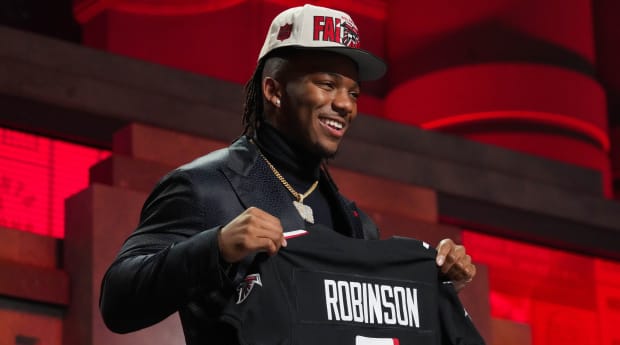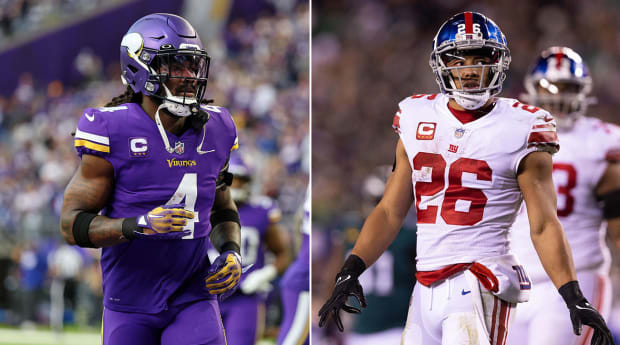I feel for NFL running backs.
All NFL positions are not created equal. And running back, aside from obvious outliers at the position, does not appear to be created equally to others from a value proposition. There has even been talk about a labor union specifically devoted to running backs, something I raised years ago, but with the NFLPA now representing all players and a collective bargaining agreement tied up through the decade, that seems more fantasy than reality.
With Dalvin Cook’s release last week and his facing an apparently tepid marketplace, the valuation of NFL running backs arises as a subject again. There is now little doubt that it is the NFL position that (1) takes the largest physical toll; (2) has the shortest shelf life; and (3) aside from punters and kickers, the lowest market value.
The financial disadvantages for NFL running backs start early and are exacerbated simply by the position that they play. It becomes a vicious cycle of NFL teams getting the most they can at the earliest, low-risk parts of their careers, before either reducing play or outright discarding players who were recently at the top of their games.
Let’s examine.
Watch the NFL with fuboTV. Start your free trial today.

Kirby Lee/USA TODAY Sports
Early-career disadvantage
The deck is stacked against running backs before they even enter the league.
The NFL’s rule—collectively bargained with the NFLPA—requires that a player be three years removed from high school for draft eligibility. For positions with typically long careers such as quarterback or offensive line, the waiting period makes sense in the cliché of “needing time to develop.” For running backs, though, this rule is harsh.
NFL history is replete with running backs who excel early in their careers before reaching a plateau or even a decline by their mid-20s. Yet in what are important years in the career arc for running backs, the three years out of high school, their earnings are limited to scholarships and, more recently, NIL money. Were NFL draft eligibility similar to other sports leagues’—allowed to enter after high school (NHL and MLB) or one year out of high school (NBA)—there would be running backs earning second contracts at age 22 or 23 instead of age 26 or 27. NFL teams are much more wary of investment into running backs even at what seem like early ages of mid-20s. There is no position that suffers career earnings diminution from the draft eligibility rule like running backs. To wit, when the rule was challenged in court, with the player actually winning at the lower level before losing at the appellate level, it was a case brought by a running back, Maurice Clarett, a player who would have had a dramatically different career and life had the rule been determined illegal.
This year’s draft featured two high-first-round running backs, Bijan Robinson (Falcons) and Jahmyr Gibbs (Lions). They will earn a lot of money and will actually be two of the highest-paid running backs in the NFL. But instead of working for nominal income at Texas (Robinson) and Alabama (Gibbs) the past couple of years, imagine if that production had been professional, with second contracts coming soon instead of in 2027 or '28 when who knows what their “tread on the tire” will be?
Much has been made of the “value” of Robinson and Gibbs being selected so high in the draft. The issue is not their talent; it is their position. In 2018, I said this of the Giants’ selection of Saquon Barkley with the second pick in the draft: He may well win Rookie of the Year, but it will not be a good value pick for the Giants (more on Barkley below). I stand by that comment.
Will Robinson and Gibbs both have strong early careers, with one perhaps winning Offensive Rookie of the Year? The odds of that are good. Will both receive strong second contracts in four or five years, after high usage rates between now and then? The odds of that are not good.
The value of early-career running back for NFL teams is strong. Five rookie running backs led their teams in rushing in 2022: Kenneth Walker III (Seahawks, second round), Brian Robinson Jr. (Commanders, third round), Dameon Pierce (Texans, fourth round), Tyler Allgeier (Falcons, fifth round) and Isiah Pacheco (Chiefs, seventh round). But that value is being rewarded financially with only fixed and reasonable rookie contract compensation. By the time these players will get to the age of true earning power for all other positions, well, the picture is bleak.

Matt Krohn/USA TODAY Sports (Cook); Bill Streicher/USA TODAY Sports (Barkley)
Veteran disadvantage
Austin Ekeler has been one of the most productive running backs in the NFL and what seemed to be an indispensable weapon for the Chargers, the past few seasons. However, when he expressed discontent with his contract earlier this offseason, the team’s response was mostly crickets. Although they eventually threw him a bone with some incentives (an easy “give” by the Chargers), the reaction—along with the lack of interest in Ekeler from other teams—was telling. The Chargers were saying, in so many words: Ekeler is a good player to have at running back, but we’re not committing any more money to him. We can always find another one.
Dalvin Cook, who had an (alleged) $12 million salary this coming year, was just released by the Vikings and faces a soft market. Ezekiel Elliott, who had four years left on an (alleged) $90 million contract, was released by the Cowboys and remains unsigned. Leonard Fournette, who signed an (alleged) three-year, $21 million contract with the Buccaneers a year ago, was discarded in March and remains unsigned. D’Andre Swift was traded from the Lions to the Eagles for a ham sandwich. Aaron Jones took a $5 million pay cut to remain with the Packers and is still one of the highest-paid running backs in the NFL. J.K. Dobbins, seeing what the future holds for running backs, is currently expressing his discontent, with little to no reaction from the Ravens.
The lack of commitment even extends to the elite at the position. Barkley, Josh Jacobs and Tony Pollard have been saddled with the franchise tag since February with, as of this writing, no purposeful movement from the Giants, Raiders or Cowboys, respectively, to change that status. The teams will apparently pay them well for what will likely be high-usage years in 2023 before a decision point next year. And the reality is this: If they are not getting top-level contract extensions this year, they are definitely not getting them next year or anytime in the future, no matter the production.
Free-agent disadvantage
This running back devaluation has had some respites over the years, but it seems exacerbated this year. Take a look at the 2023 free-agent market, even compared to last offseason.
In 2022, James Conner received $13.5 million guaranteed from the Cardinals. This year’s top free-agent running back, Miles Sanders, received a similar $13.2 guaranteed from the Panthers, although Sanders averaged 1.2 yards per carry more than Conner in his contract year. Jamaal Williams, with statistics virtually identical to Conner’s, received $8.15 million guaranteed from the Saints, $4.35 million less than Conner.
In 2022, Chase Edmonds and Rashaad Penny signed one-year deals for $6.1 million and $5.75 million, respectively. In ’23 neither player eclipsed $1.5 million.
In 2021, Nyheim Hines signed an extension with $12 million guaranteed. In ’23, Devin Singletary, who started for the Bills ahead of Hines and had a much more productive season in his contract year, received $2.5 million guaranteed.
These are just a few examples; there are more free-agent running back contracts that are not even worth mentioning.
Free agency is the most leveraged time in an athlete’s career, with the most bargaining power they will ever have. Except, of course, if the athlete is an NFL running back.
The counterintuitive: more production, less value
Running backs have the most counterintuitive production-to-value model in sports.
For every other position in the NFL, or all sports (and business), the model seems clear: the greater the production, the greater the future market value. What seems clear, however, is that when it comes to running backs, the opposite is true: the greater the early career production, the less future market and contract value.
Teams leverage running backs’ early careers, when they are as fresh-legged and injury-free, as much as possible, to load usage for high productivity. All the while the teams know they will be unlikely to “buy” later career years (if there is a later career). Load management, a popular term in the NBA and with MLB pitchers, is not a strategy for NFL running backs. It is more the opposite: high usage in early, low-risk (to the team) years, and then on to the next young running back.
Teams have spoken with their actions: At a certain age, running backs—even those who appear to be the best ones playing—have served their purpose and are removed from the team. Teams are confident they can, and will, find younger and cheaper replacements.
In sports, as in business, value is created by scarcity. The most valuable jobs are the ones where it is hardest to find people with the competence and excellence to do them. Those positions in the NFL tend to be quarterback, edge rusher, offensive tackle, cornerback and, in recent years, even wide receiver. As for running backs, well, the universal feeling is that “you can find them” without the need to spend significant cash or cap resources. Sure, there will be the outliers, such as Christian McCaffrey and Derrick Henry, but they are the exceptions, not the rule.
I feel for NFL running backs.







